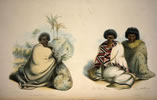The United Tribes’ flag (1834) can be seen as the first Māori flag, but it was not designed by Māori. Indigenous flags emerged in the lead-up to the New Zealand wars of the mid-19th century. Māori recognised the symbolic power of the Union Jack and the importance Pākehā attached to the raising and lowering of flags. They sought to assert their own power and independence by devising flags. Crosses, crescent moons and stars, fusing Christian and traditional beliefs, were common flag motifs.
First flags
From the early 19th century some Māori used clothing as flags – particularly cloaks belonging to chiefs. These could perhaps be interpreted as the first Māori flags.
Kīngitanga flags
When Waikato tribal leader Pōtatau Te Wherowhero accepted the position of Māori king in 1857, flags representing the Kīngitanga (Māori king movement) were hoisted. One flag bore the word ‘Kingi’ (king) and another ‘Niu Tireni’ (New Zealand). The flags always contained three small crosses, which probably represented the three islands of New Zealand.
When Tāwhiao was installed as the second Māori king in 1861, a special flag was hoisted at Ngāruawāhia. Succeeding Māori monarchs continued this tradition, and each have had their own flag. When they die the flag is buried with them, and a new flag is devised to represent the new monarch.
Far from home
The British Museum in London has a 19th-century Māori flax-fibre flag in its collection. The flag’s provenance is unknown but visual clues have led scholar Kane Te Manakura to suggest it is the flag of a Māori prophet active in the mid-19th century. The flag is a pennant (triangular in shape). It depicts a man of chiefly status and a tuatara, both embroidered in red wool at the hoist end, which is trimmed with red and orange kākā (native parrot) feathers.
Prophetic-movement flags
Flags and flagpoles were important devices of power for the Māori prophetic movements that developed in the 1860s. The religious rituals of Pai Mārire, a movement led by the prophet Te Ua Haumēne, were based on niu (news) poles and flags. Adherents believed the cracking sound produced by the ropes and flags in the wind contained messages from God. Flags symbolising the deities Rura (peace) and Riki (war) were created. Te Ua had his own flag, as did his followers Tītokowaru and Te Peehi Tūroa.
Ringatū leader Te Kooti also used flags laden with symbolic meaning. They were taken into battle and some were captured by colonial forces, becoming war trophies.
Gifted flags
After the New Zealand wars of the 1860s the government presented flags to Māori chiefs and tribes who had fought alongside colonial forces. The British and later the New Zealand Red Ensign – a maritime flag – were the most common flags presented. The ensign included the tribe’s name or their ancestral canoe along the bottom – a practice eventually enshrined in law by the Flags, Emblems, and Names Protection Act 1981.
In 1865 some women settlers of Whanganui presented a white silk flag to lower-river Whanganui Māori after they defeated up-river iwi, who were Pai Mārire supporters, at Moutua Island in 1864. In addition to a Union Jack and crown, it showed a brown hand and a white hand clasped, suggesting friendship between Māori and Pākehā.
Tino rangatiratanga flag
The flag commonly known as the tino rangatiratanga flag was designed in 1989. A Northland-based group, Te Kawariki, ran a national Māori flag competition but none of the entries were chosen. A group of Māori women artists was approached and three of the members submitted a winning design. Their flag was flown during a hīkoi (march) from Te Rerenga Wairua (Cape Rēinga) to Waitangi in the lead-up to Waitangi Day in 1990.
The flag has become a symbol of Māori independence. In 1999 protesters climbed a flagpole at the Waitangi treaty grounds and substituted the tino rangatiratanga flag for the New Zealand flag and the naval White Ensign.
In 2007 a Māori independence group asked Transit New Zealand (the national highway authority) if they could fly the tino rangatiratanga flag atop the Auckland Harbour Bridge on Waitangi Day, but Transit refused the request.
The Māori Party (later Te Pāti Māori) supported the National-led government formed in 2008 and party co-leader Pita Sharples took up the issue. Prime Minister John Key said a Māori flag could fly on the bridge if Māori could agree on a flag. The tino rangatiratanga flag was chosen after a public consultation process, and was flown over the bridge and in other public locations on Waitangi Day 2010. It became the national Māori flag.



